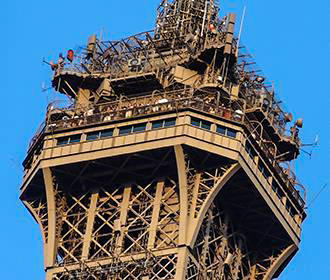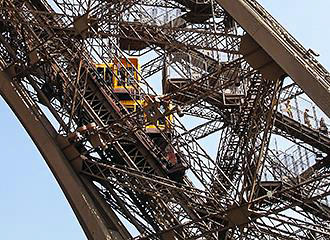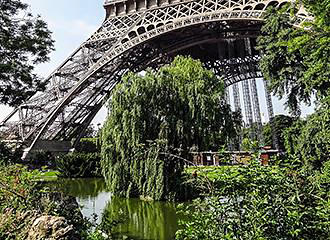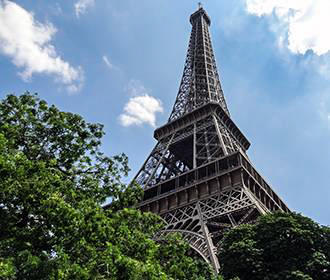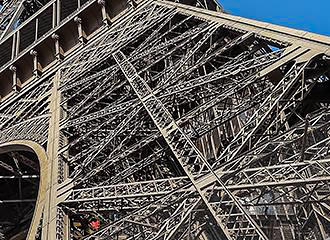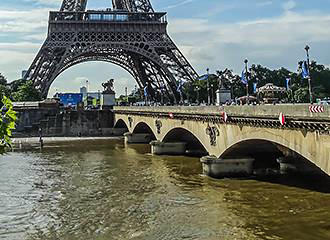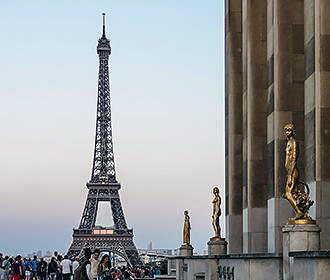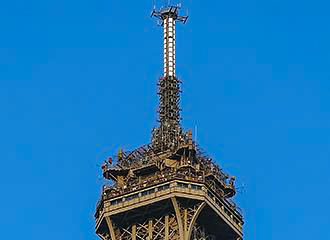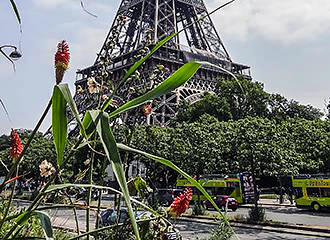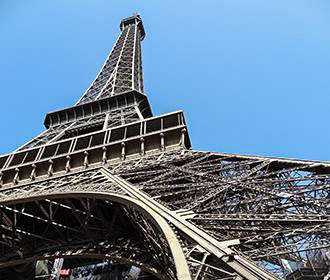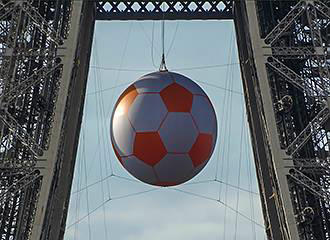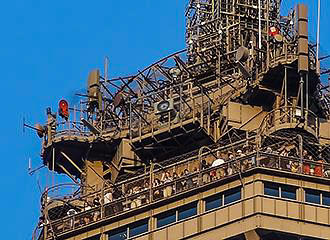Facts on the Eiffel Tower in Paris
Having become an icon throughout the world that is visited by over 7 million people every year that are on holiday in Paris, this incredible monument has a fascination for many in numerous different aspects.
Whether it be the science, technology and communications, the history of the Eiffel Tower or the impressive lighting, there is so much to discover and to follow are some of the figures and facts that may be of interest.
Building and construction of the Eiffel Tower
There were 50 designers and engineers that produced around 5,300 drawings for all aspects of the towers construction with an initial height of 312 metres to the top of the flag pole, yet with the antennas added to the top of the tower, which now total 120, the new height is 324 metres.
It took 100 workers to built more than 18,000 different parts for the tower within a workshop on the outskirts of Paris, and these were then assembled on site by an additional 132 workers and the whole project was completed in record time, which was 2 years, 2 months and 5 days.
There are four pillars that are positioned in a square and measure 125 metres on each side, but incredibly, the lowest foundations are only 15 metres underground.
Iron was chosen by Gustave Eiffel who was the engineer that designed the Eiffel Tower, which is also why it often gets the nickname of the Iron Lady, and the total number of iron parts used was in its construction was 18,038 and that, combined with the 2,500,000 rivets used, makes the metal structure itself weigh in at 7,300 tons, however, the total weight of the Eiffel Tower is 10,100 tons.
There were a total of five elevators at the Eiffel Tower when it was first opened to the public in the June of 1889 one in each of the pillars and one that went from the second to the third floor. And there was a spiral staircase that Gustave Eiffel used in order to get to his office and science laboratory. In fact, he and the Paris dignitaries climbed the 1,710 stairs to the top in order to plant the French flag on the inauguration day back in the March of 1889 and a section of the original spiral staircase is on view at the tower.
Today, there are still the elevators in the pillars including the exclusive Jules Verne restaurant elevator and a goods elevator along with double cabin elevators between the second and third floors, however, there is also a staircase in the East pillar and it is a total of 1,665 steps to the top of the tower.
The height to the first floor of the Eiffel Tower is 57 metres and with a surface area of 4,415m squared, this is where you can see different exhibitions, enjoy the shops, boutiques, buffets and the 58 Tour Eiffel restaurant.
The height to the second floor is 115 metres and obviously there are still elevators in place in order to access this, although, if you do feel a bit energetic, for an entirely different view you can experience the 704 stairs to the second floor. But if you are dining at the Jules Verne restaurant, then you would take the private elevator to the second floor, which is for the exclusive use of its patrons.
The surface area of this floor is 1,430m squared and on this floor there are also viewing points for the panorama, the Eiffel Tower buffet restaurant, etc.
The height to the third floor is 276 metres with a surface area of 250m squared and there is an open air area on this final floor for panoramic views as far as the eye can see, and here is where you can get to the top of the tower. You can also get to the Champagne Bar if you want to sip a glass of champagne on a special occasion, whilst admiring the fabulous views over Paris.
Lighting and illuminations at the Eiffel Tower have always been in place since it very first opened and at that time there were 10,000 gas lights to enhance the look of the Iron Lady, but over the years these have been replaced.
Today there are a total of 336 lamps that give the Eiffel Tower is golden glow and there are 20,000 bulbs that provide the twinkling lights that are on for five minutes on the hour every hour of an evening until 1am.
This incredible landmark in Paris is equipped with a state of the art surveillance system that monitors everything from the structure itself through to security and fire risks. And talking of fires, there is a complete sprinkler network and the fire hydrants on the first two floors are fed from the ground, whereas the top floor is supplied by pressurised water tanks.
Painting of the Eiffel Tower
Because this landmark in Paris is made of iron, it needs to be protected from the elements and therefore the whole surface is covered in paint.
The very first coat of paint was in red iron ochre covered with linseed oil and this was completed in the March of 1889 and then two months later a fourth glazed coat was added, however, by 1892 the Eiffel Tower needed re-painting and this time it was in yellow ochre paint and guaranteed for five years.
By 1899, the Eiffel Tower again needed re-painting, and it was decided that it should be done every 7 years from then on and they colour coordinate the paint with three different shades.
After several changes to its colour, the three tone variation of bronze was decided upon back in 1968, in order to complement the surroundings, going from the darkest shade at the bottom, to the lightest at the top.
As you can no doubt imagine, the tower is monitored at all times, but there is also a specialist team of climbers that monitor the structure and the condition of the paint, especially in the hard to reach areas and it now takes approximately 18 months to completely repaint the whole of the structure with 25 professional painters.
When the Eiffel Tower was painted in 2001 they also used a lead free paint, always trying to consider environmental issues, but did you realise that approximately 60 tons of paint are required each time for this mammoth task?
Of course, these are the basic figures and facts on this incredible monument, but there are many more along with many quirky and unusual feats, exploits and facts that have taken place over the years at the Eiffel Tower in Paris.
Some events along with quirky and unusual facts on the Eiffel Tower
Did you know that the Eiifel Tower is affected by heat? Well, when it is hot and the tower is exposed to the sun, it will expand more in the areas that have the sun rather than the sides that are in the shade. And to try and get out of the sun, the tower can lean as much as 18cm!
Obviously wind always plays a major role with stability of tall buildings and this landmark in Paris is no exception. In fact, after the major storm in 1999, the Eiffel Tower moved from its original position by over 10cm!
However, there is a tower observatory at the top and when you visit the tower whilst you are on holiday in Paris, you can find out more about the oscillations of the top of the tower through wind and sun along with facts about Gustave Eiffel himself, the construction of the tower and much more. But for professionals and by prior arrangement well in advance you can also get to see other archives from the Eiffel Tower at the Musee d’Orsay in Paris.
There was a printing press installed at the Eiffel Tower back in 1889 and you could purchase a copy with your own name inscribed on it, just to prove that you had been up the tower.
Yet, today, there is actually a post office where you can send off postcards with the unique Eiffel Tower postmark, so that, again, people will be able to verify that you have actually visited the Eiffel Tower!
Being such a world renowned monument and the icon of Paris and France, there have been numerous films, books, paintings, etc that have incorporated the Eiffel Tower such as Condorman, An American Werewolf, The Da Vinci Code and Even Rush Hour 3 with Jackie Chan and Chris Tucker who were filmed doing stunts at the Eiffel tower whilst on location.
Talking of celebrities and famous people.. Because of its world renown, virtually anyone that is a somebody has visited the Eiffel Tower from Presidents and Prime Ministers through to Royalty from numerous countries.
Just some of the famous people you may recognise the names of, like Buffalo Bill, Thomas Edison, Sarah Bernhardt, the singer Edith Piaf, the first cosmonaut Yuri Gagarin, Maurice Chevalier and many more have visited this landmark in Paris.
And this does not include the private visits that celebrities like Michael Jackson, Boris Yeltsin and Pierce Brosnan have had in different years gone by.
A timeline of some events at the Eiffel Tower
In 1905 there was race up the stairs to the first floor that was organised by Le Sport, but surprisingly, the winners prize was a bike!
In the October of 1909 a Wright Brothers aircraft made of wood and canvas flew around the tower, which was the first time in aviation history.
For the 50th Anniversary of the towers existence in 1939, high mass was conducted on the first floor in the presence of the Archbishop of Paris.
Made of three bed sheets that were sewn together in the colours that symbolised liberated Paris, a flag was raised to the top of the tower in the August of 1944.
The oldest elephant in the world, at an age of 85 from the famous Cirque d’Hiver Bouglione circus in Paris, made it to the first floor of the Eiffel Tower in 1948.
To celebrate the 75th Anniversary of the tower in 1964, two mountaineers climbed the tower, with the event being broadcast by Eurovision.
In 1983 an auction was conducted to sell off parts of the original spiral staircase that Gustave Eiffel used in order to reach his office and science laboratory, however, there still remains part of this original staircase on display at the Eiffel Tower for all to admire and reminisce of times gone by.
In 1989 for the 100th Anniversary of the Eiffel Tower, the tightrope walker, Philippe Petit tightrope walks 700 metres from the Palais de Chaillot to the tower.
75 athletes take part in a race to climb the stairs of the tower in 1995 and Yves Lossouarn breaks the record with a time of only 8 minutes and 51 seconds.
1997 saw a professional stuntman parachutes from the Eiffel Tower and in the same year there were 85 tons of pumpkins installed into the Trocadero gardens to celebrate Halloween.
Hugue Richard breaks the records for climbing the stairs from the ground floor to the second floor on a mountain bike in 1998. However, the record was beaten several times and by 2002 he had broken the world records to regain his title again.
This same year, the tower welcomed its 200 millionth visitor since it opened in 1889 and there was also a large heart made from vine stocks that was placed at the bottom of the Eiffel Tower in memory of those affected by the explosion at the AZF plant in Toulouse in the Midi Pyrenees region of France.
A gentleman from Andorra went into the Guinness Book of World Records when he climbed the 1,300 steps on a mountain bike in 2004 and in 2005 Jerome Sue descended the 345 steps from the first floor to the ground floor in a wheelchair.
And in 2006, the French monocycle champion, Yoggi, who managed to go up the stairs to the second floor of the Eiffel tower in only 22 minutes on his monocycle without once touching the ground!
In 2007, during September and October for the Rugby World Cup held in France, the Eiffel Tower adopted the rugby colours including the tower in green light representing the pitch, along with a giant rugby ball spanning 13 metres was suspended from the second floor, approximately 80 metres from the ground.
On 13th November 2015, Paris suffered horrendous terror attacks, and in solidarity for the victims, the Eiffel Tower was lit up with the colours of the French flag - red at the bottom, white in the middle and blue at the top - which is also the same sort of feature that happened to other icons in the world as recognition and respect to France and all those that suffered.
In 2016 France was playing host to Euro 2016 football, and just like with the rugby, an enormous football was hung from the Eiffel Tower bearing the official logo and a giant screen was set up facing the River Seine for live coverage of the games, plus it was lit up in the colours of the Welsh flag, after the historical Euro 2016 victory over Slovakia.
The Smash Perrier contest arose in 2017, which was organised by Perrier and the French Open tennis Roland Garros tournament to run alongside this famous event and winners of the contest were able to zip line from the second floor of the Eiffel Tower down over the Champ de Mars.
2018 saw the completion of the renovated gardens on either side of the Eiffel Tower with these historical gardens being classified as Listed Wooded Spaces, which includes around 2000 shrubs and 20,000 perennial plants.
The same year saw a new safety perimeter put in place to encompass these historical gardens with their water features with a 3.24 metre high fence made out of a weather-resistant material called Corten steel, which was specifically designed for the Eiffel Tower to incoprotate flowing lines like the icon itself.
However, two sides have a highly transparent glass wall, which face the Champ de Mars and Trocadero, both of which are classified as listed views, and designed by the Austrian architect Dietmar Feichtinger who also designed the Passerelle Simone de Beauvoir footbridge over the River Seine, this glass wall was also put in place in 2018, completing the perimeter where there are now security checkpoints in order to access the Eiffel Tower and its gardens.
2019 marked the 130th Anniversary of the Eiffel Tower, and to commemorate this, a limited edition of 600 historical rivets were on sale with documentation of authenticity and presented in a traditional style wooden display case.
In January 2020 two NBA American teams, the Milwaukee Bucks and Charlotte Hornets were welcomed at the Eiffel Tower for a press conference before the game held at AccorHotels Arena, formerly the POPB and often known as Bercy Arena in Paris.
Now obviously these are just some of the events at the Eiffel Tower that have taken place over the years, and there have been some unauthorised activities as well as the planned. But this monument in Paris will continue to fascinate people from all over the world for many years to come, and it is without a doubt that there will be many more events that occur in the coming years.
